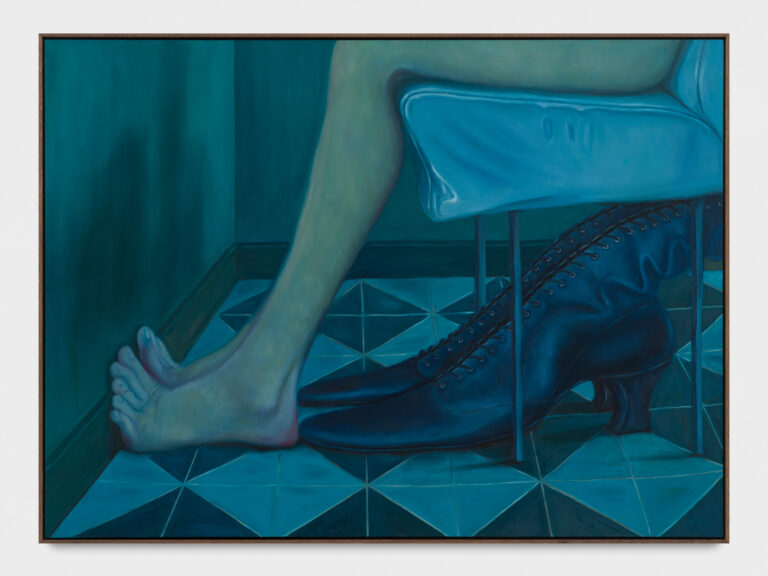What are you looking for? Curated by Brandy Carstens
With works by Afra Al Dhaheri, Lorenzo Amos, Beatrice Arraes, Alvaro Barrington, Lee Bontecou, June Crespo, Luisa Gardini, Rajyashri Goody, Salim Green, Kenji Ide, Olivia van Kuiken, Heidi Lau, Kate Mosher Hall, Chemu Ng'ok, Alexandra Noel, Haim Steinbach, Anh Trần, Nora Turato, Kaari Upson, Evian Wenyi Zhang, Julia Yerger
2 MAY until 7 JUN 2025
Opening – 2 MAY 2025, 6-9 pm

Kaari Upson,
Untitled, 2011
Marianna Simnett
Charades
2 MAY until 28 JUN 2025
Opening – 2 MAY 2025, 6-9 pm
Société is pleased to announce a solo exhibition with the British-Croatian artist Marianna Simnett.

Marianna Simnett,
Scored, 2025;
Courtesy the artist and Société, Berlin;
Ph: Trevor Good
In Charades, the artist’s second solo exhibition with the gallery, Simnett delves into the fluid boundaries between individual and collective behavior in new works that explore notions of masquerade, power, and ritual. Drawing on mythology, social rituals, and rites of passage, her new video, paintings, and sculptures evince a deep fascination with ever-shifting presentations of the self, which manifest in flamboyant, macabre displays that flout social taboos and expectations. The works’ frequent invocation of theatrical elements and techniques underscore the underlying tension at the heart of performative excess–its ability to disrupt established norms and recuperate space for difference, while also being weaponized to deceive, manipulate, or obscure.
The video work Leda Was a Swan extends Simnett’s ongoing interest in warping ancient myth to explore fundamental questions about power, desire, and the Other. Inspired by her research into a recently uncovered fresco of Leda in Pompeii, the work revisits the ancient Greek myth in which Zeus, disguised as a swan, assaults the Spartan queen. Simnett’s reinterpretation of the story complicates the traditional victimaggressor binary, depicting Leda not as a passive victim of Zeus’ aggression, but a complex figure capable of desire, choice, and subversion. Zeus is incarnated as a puppet, Leda’s own hand, a disquieting subversion that is reflected in Simnett’s use of a custom AI model to generate animated sequences from the video’s imagery, further complicating the power-play between puppet and master, human and machine.
A focus on the mutability of power—its construction, subversion, and performance—carries throughout the exhibition. This is particularly evident in Simnett’s recent sculptural works, where familiar symbols are transformed into opulent, ornamental forms that question the nature of control: symbols of feminine beauty veer toward the grotesque, while sacrosanct rites of passage appear as lavishly embellished finger puppetry. These works subtly parody the reliquary—with its ornate enshrinement of power, sanctity, and devotion— serving instead to unravel the ambivalence, fetishization, and performativity of veneration. The merkin, a form of pubic covering dating back to the 16th century, makes a subtle appearance in the costuming for Leda Was a Swan, gesturing toward the historical and contemporary policing of gender and sexuality. Its paradoxical nature—as both a means of protection and an object of exposure—underscores its function as both armor or embellishment, a means of concealment or display, which Simnett further explores in a sculptural work that takes the form of a merkin case full of masquerade paraphernalia.
A dreamlike sense of suspense and melancholy pervades a new series of oil paintings, which oscillate between intimate rituals and lavish spectacle. Seething beneath these seemingly disparate moments are intimate choreographies of dominance and submission—felt in the seduction of performance, the lull of social traditions, or the soft friction of being pushed just slightly too hard. Charades draws its title from the classic parlor game in which one person acts out a syllable while others guess the entire word or phrase. Yet, beyond its playful origins, the term “charade” has also come to signify a sham, a pretence, a mask, a mockery, or a false display—concepts that pervade our lived experience and, in Simnett’s oeuvre, are examined to reveal the subtle crossover from playful to insidious performativity.
Marianna Simnett (b. 1986, London) lives and works in Berlin and New York. Her work was part of Manifesta 15, Barcelona and her solo exhibition WINNER was recently on view at Hamburger Bahnhof, Berlin. Simnett’s first work for the stage, entitled GORGON, was commissioned by LAS Art Foundation and premiered at HAU 2, Berlin in 2023. Her work The Severed Tail was presented at the 59th Venice Biennale: The Milk of Dreams and at the 66th BFI London Film Festival, British Film Institute, London. Simnett has had solo exhibitions internationally at venues including City Gallery Wellington, Wellington; Copenhagen Contemporary, Copenhagen; MA, Institute of Modern Art, Brisbane; Frans Hals Museum, Haarlem; Kunsthalle Zürich, Zürich; MMK, Museum für Moderne Kunst, Frankfurt; The New Museum, New York; and Zabludowicz Collection, London.
